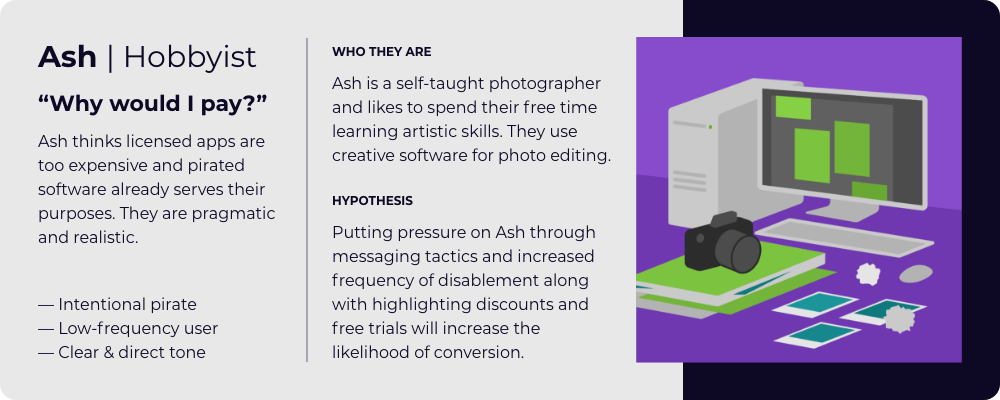In an ever-evolving landscape of digital optimization, prioritizing what and where to test can often feel disorienting.
With countless variables like testing runtimes, page selection, and scope for design and development, it’s easy to feel directionless. But fear not, our Conversion Compass can point your optimization efforts in the right direction.
Imagine having a personalized testing plan for your e-commerce site, designed just for your brand. We create this plan using two key ingredients. First, we dive into your customer behavior data to gather valuable insights. Second, we leverage proven optimization techniques that work specifically for your industry.
That’s the magic of our Conversion Compass program. It’s a strategic tool that reveals the clearest path to success and gives you the confidence to take measurable steps towards increasing conversions. With Conversion Compass, you’ll have a roadmap to guide your testing efforts, ensuring that each experiment brings you closer to your goals
But roadmapping isn’t just a list of random tests; it’s a strategic process involving stakeholder collaboration, objective setting, data analysis, and prioritization based on impact and alignment with business goals.
In this blog, we break down 5 pro-tips for key roadmapping phases.
Account Onboarding & Business Objectives Distillation
- Ensure alignment: Collaborate closely with key stakeholders across departments to ensure that the defined business objectives align with the overall organizational goals. Make sure to break down the WHY behind the objectives.
- Focus on measurability: Clearly define measurable goals and key performance indicators that will be used to track the success of the A/B testing roadmap.
- Prioritize objectives: Identify and prioritize business objectives based on their potential impact on revenue, customer satisfaction, or other relevant metrics. Build a few ROI models to best understand what your biggest levers are.
- Set realistic timelines: Establish realistic timelines for achieving each objective, taking into account resource availability and potential dependencies. Break them into phases and milestones enabling you to track progress effectively and determine if adjustments to the overall goal or strategy are necessary.
- Document thoroughly: Document all discussions, decisions, and action items from the onboarding process to ensure clarity and accountability throughout the roadmapping journey.
Data & Insights Analysis:
- Gather comprehensive data: Collect data from various sources, including website analytics, historic tests, customer feedback, and market research, to gain a holistic portfolio of data.
- Transform data into insights: Data isn’t useful by itself. It’s the insights and application that derives from it that creates value. Focus on extracting meaningful insights that provide clarity on their significance and potential impact.
- Rank your Insights: Make note of your favorite insights, these can be ones that offer biggest ROI potential, spark the most design ideas, or perhaps it reveals several follow up questions that can be answered through testing.
- Define 3-4 optimization themes: Identify patterns, trends, and correlations within the data that directly connect to the business objectives. Define these patterns as optimization themes by attaching a strategy that can create a better experience for users. Every test should be connected to an optimization theme.
- Bucket insights into themes: With optimization themes defined, begin to organize your insights by bucketing them within your themes, this will help create clear direction and guardrails for future ideation sessions.

Ideation Session & Generation of Backlog:
- Foster creativity: Create a collaborative and supportive environment that encourages team members to think outside the box and share innovative ideas.
- Set clear guardrails and structure: Focus on one optimization theme at a time. Make sure ideas fit the theme and are based on data insights. Look at specific parts of your site, and move on when you’ve explored all the ideas for that area.
- Prioritize quality over quantity: Focus on generating high-quality test ideas that are based on data insights, user research, and best practices rather than aiming for sheer volume.
- Test hypothesis diversity: Include a mix of hypothesis types, such as usability improvements, feature enhancements, messaging variations, and design changes, to cover a wide range of potential tests.
- Document and organize: Document all generated test ideas in a centralized backlog, categorizing them based on themes, potential impact, and alignment with business objectives for easy reference and prioritization.
Prioritization and Roadmap phase:
- Rank Your Tests: Identify key factors that matter to your business. Score each test idea based on its potential impact on these factors. Give each idea a number score to easily compare and rank them.
- Balance Effort and Impact: Look at how much work each test takes to run and put into action. Compare this to the expected impact of the test. Prioritize tests that offer a big impact for a reasonable amount of effort. This helps you get the best bang for your buck in your optimization work.
- Iterative vs Innovative Approach: Create a roadmap that balances two types of tests: innovative and iterative. Innovative tests are big, complex changes that can have a major impact, either good or bad. Iterative tests are smaller, focused experiments that help you learn and improve gradually. Aim for about 75% iterative and 25% innovative tests. This mix helps you test quickly, boost revenue, and gain clear insights.
- Stakeholder Alignment: Involve key stakeholders when prioritizing tests. This ensures your testing plan aligns with your organization’s goals and priorities. Work to get everyone’s buy-in on the final roadmap.
- Capture, Monitor and Review: Once everyone agrees on the roadmap, take a screenshot for your records. Regularly check on running tests and review finished ones. Make sure you’re meeting your testing goals and deadlines. After each test, think about what worked, what didn’t, and what you learned. Use these insights to make your testing process even better.
Conversion Compass is a strategic solution designed to simplify the complexities of digital optimization. Our team of experts will work closely with you to develop a custom roadmap tailored to your site’s unique needs and goals. The program combines the power of data-driven insights with proven optimization strategies to help you identify and prioritize the tests and changes that will have the greatest impact on your bottom line. Contact our team today to schedule a consultation and discover how Conversion Compass can help you chart a course to conversion success.









